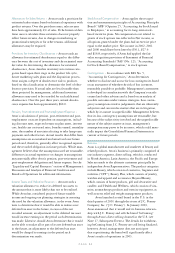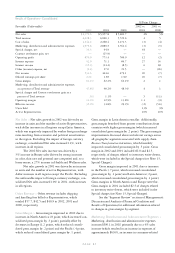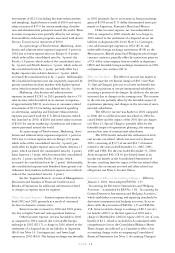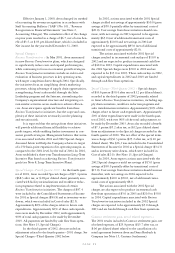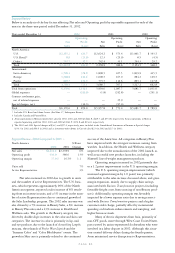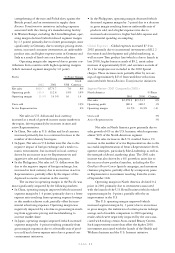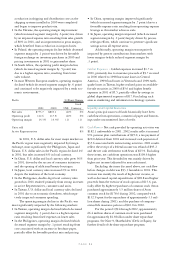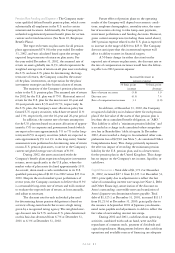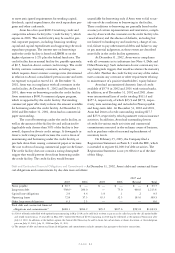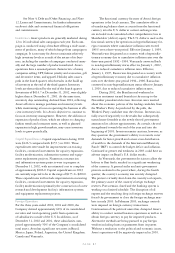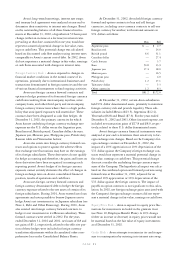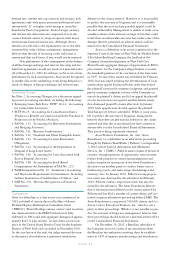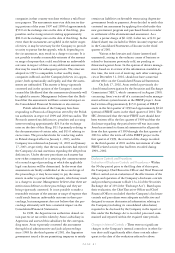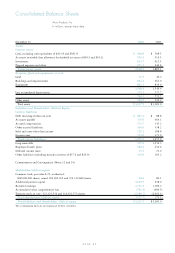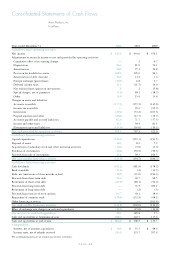Avon 2001 Annual Report Download - page 13
Download and view the complete annual report
Please find page 13 of the 2001 Avon annual report below. You can navigate through the pages in the report by either clicking on the pages listed below, or by using the keyword search tool below to find specific information within the annual report.
PAGE 37
See Note 4, Debt and Other Financing, and Note
12, Leases and Commitments, for further information
on Avon’s debt and contractual financial obligations
and commitments.
Inventories > Avon’s products are generally marketed during
12 to 26 individual sales campaigns each year. Each cam-
paign is conducted using a brochure offering a wide assort-
ment of products, many of which change from campaign to
campaign. It is necessary for Avon to maintain relatively
high inventory levels as a result of the nature of its busi-
ness, including the number of campaigns conducted annu-
ally and the large number of products marketed. Avon’s
operations have a seasonal pattern characteristic of many
companies selling CFT, fashion jewelry and accessories, gift
and decorative items, and apparel. Holiday sales cause a
peak in the fourth quarter, which results in the build up
of inventory at the end of the third quarter. Inventory
levels are then reduced by the end of the fourth quarter.
Inventories of $614.7 at December 31, 2002, were slightly
higher than at December 31, 2001. At the same time,
inventory days outstanding declined from 2001, reflecting
Avon’s efforts to manage purchases and inventory levels
while maintaining a focus on operating the business at effi-
cient inventory levels. It is Avon’s objective to continue to
focus on inventory management. However, the addition or
expansion of product lines, which are subject to changing
fashion trends and consumer tastes, as well as planned
expansion in high growth markets, may cause inventory
levels to grow periodically.
Capital Expenditures > Capital expenditures during 2002
were $126.5 compared with $155.3 in 2001. Those
expenditures were made for improvements on existing
facilities, continued investments for capacity expansion,
facility modernization, information systems and equip-
ment replacement projects. Numerous construction
and information systems projects were in progress at
December 31, 2002, with an estimated cost to complete
of approximately $206.0. Capital expenditures in 2003
are currently expected to be in the range of $175.0–$200.0.
These expenditures will include improvements on existing
facilities, continued investments for capacity expansion,
facility modernization (primarily the construction of a new
research and development facility), information systems
and equipment replacement projects.
Foreign Operations
For the three years ended 2002, 2001 and 2000, the
Company derived approximately 60% of its consolidated
net sales and total operating profit from operations
of subsidiaries outside of the U.S. In addition, as of
December 31, 2002 and 2001, these subsidiaries com-
prised approximately 50% of the Company’s consolidated
total assets. Avon has significant net assets in Brazil,
Mexico, Japan, Poland, Argentina, the United Kingdom,
Canada and Venezuela.
The functional currency for most of Avon’s foreign
operations is the local currency. The cumulative effects
of translating balance sheet accounts from the functional
currency into the U.S. dollar at current exchange rates
are included in Accumulated other comprehensive loss in
Shareholders’ (deficit) equity. The U.S. dollar is used as the
functional currency for operations in hyperinflationary for-
eign economies where cumulative inflation rates exceed
100% over a three-year period. Effective January 1, 1995,
Venezuela was designated as a country with a hyperinfla-
tionary economy due to cumulative inflation rates over the
three-year period 1992–1994. Venezuela converted back
to non-hyperinflationary status effective January 1, 2002,
due to reduced cumulative inflation rates. Effective
January 1, 1997, Russia was designated as a country with
a hyperinflationary economy due to cumulative inflation
rates over the three-year period 1994–1996. Russia has
converted to non-hyperinflationary status effective January
1, 2003, due to reduced cumulative inflation rates.
During 2002, the Brazilian real weakened as
investor sentiment turned bearish in the run up to the
November presidential election. Investors were worried
about the economic policies of the leading candidate from
the Worker’s Party. As predicted by the polls, the
Worker’s Party candidate won the election. Investors ini-
tially reacted negatively to the results but subsequently
turned more favorable as the newly elected government
announced its cabinet appointments. As a result, the real
strengthened towards the end of the year and into the
beginning of 2003. Investors remain cautious, however, as
they question the government’s ability to reconcile voter
demands for faster growth and a more even distribution
of wealth to the demands of the International Monetary
Fund (“IMF”) to control the budget deficit and inflation.
Continued or greater real weakness in 2003 could have an
adverse impact on Brazil’s U.S. dollar results.
In Venezuela, the government decision to allow the
bolivar to float freely resulted in a significant weakening
of the currency. A general strike and anti-government
protests escalated to the point where, during the fourth
quarter, the country’s economy was severely disrupted.
The protests virtually shut down the country’s oil exports,
the primary source of the country’s foreign exchange
reserves. Ports remain closed and the banking system is
working on a limited schedule. The disruption of oil
exports and the resulting drop in foreign exchange reserves
forced the government to close the foreign exchange mar-
kets in early 2003. In February 2003, exchange controls
were imposed on foreign currency transactions.
Continuation of the political unrest has disrupted Avon’s
ability to conduct normal business operations as well as to
obtain foreign currency to pay for imported products.
Alternative methods are being pursued to pay foreign
vendors including loans or guarantees from its parent.
Without a resolution to the political and economic issues,
Avon’s operations will be negatively impacted in 2003.


